
 WWW.COROMANDELLIFE.CO.NZ
WWW.COROMANDELLIFE.CO.NZ
31
by MARk GEE
“I just returned from Great Barrier where I ran an astrophotography
workshop. I was surprised and impressed by how dark the skies
were. I thought they may have been somewhat affected from the light
pollution of Auckland, but I quickly found that wasn’t the case. The
clarity in the sky was incredible, with features of the Milky Way you
could see with the naked eye that simply isn’t possible elsewhere. I
shot this image literally 5 steps from my accommodation at Orama
Oasis. It’s so dark there – especially when the generators stop at
10.30pm each night. The red glow you see is airglow, and the bright
star in the middle of frame is the planet Jupiter.”
- Mark Gee
Great Barrier Island
NZ Awarded Two prestigious
‘Dark Sky’ Designations
Happily, efforts are being made to help preserve our valuable NZ
dark skies. A few years ago the Mackenzie Basin area around
Lake Tekapo was given the prestigious designation as a ‘Dark
Sky Reserve’ by the International Dark Sky Association. This is
the largest reserve of its type in the world and acknowledges the
importance of the large research telescopes at Mt. John, and the
need to preserve that darkness.
Last year an even more important designation of a ‘Dark Sky
Sanctuary’ was awarded to Great Barrier Island (Aotea), a designation
shared at that time by only two other sites in the world; one in Chile
and one in the New Mexico desert.
Astro-tourism businesses ranging from night sky tours and
accommodation to astrophotography courses have been established
at both Great Barrier and Tekapo. A new $10 million astro-tourism
centre is now under construction on the shores of Lake Tekapo with
funding from government and private interests, including local Iwi.
Since receiving its coveted Dark Sky Sanctuary status, Great Barrier
has seen a flourish of related businesses that offer astrophotography
guidance, tours and the use of equipment. There are even qualified
‘Dark Sky Ambassadors’ who offer a unique night under the stars
experience at your accommodation.
The ongoing success and status of the Great Barrier Island Sanctuary
will depend on controls on the increasing numbers of ever brighter
lights from Auckland and the east coast Coromandel settlements
of Matarangi, Whangapoua and Whitianga. Kuaotunu residents are
actively making the wider community aware of light pollution so future
developments will help preserve the dark sky ‘taonga’ we all enjoy.
See below for more from Astronomer Alastair Brickell and for more
details of the Dark Sky designation programme:
www.darksky.org/idspVisit Stargazers B&B and Astronomy Tours for a delightful stay or a
‘tour of the skies’. Alastair has an impressive observatory, including
the largest telescope on the Coromandel for those who want to
learn more and see those night skies close up.
However, ‘Houston, we have a problem!’ As Mars
has been getting closer to the Sun, its atmosphere
has been heating up. And in early June a dust storm
was whipped up on its surface. This has now grown
to be a planet wide event; the biggest one since at
least 2007 and maybe even 1977.
NASA announced on June 26 that the 14-year-old
Opportunity Rover
ran out of vital heating power
from its solar panels as the sky became ever
darker. They hope it regains power after these
storms subside, but NASA’s nuclear-powered rover
Curiosity
is unaffected and studying the extreme
weather conditions.
It is hoped that this global storm will subside by late
July so we can all get a glimpse of Mars’ elusive
surface during this rare close approach.
Other bright objects in the winter sky are brilliant
Venus low in the northwest after dusk with bright
Jupiter above it. In between this and Mars lies
slightly yellowish Saturn, itself a lovely sight in a big
telescope. So regardless of the weather on Mars,
this winter there will still be plenty to enjoy in our
lovely dark skies.
Mars Rules the Night
Alastair Brickell from Stargazers
Stargazers, even those in the cities, are in
for a real treat over winter with a parade of
planets on display. Mars will undoubtedly be
the star of the show as it will be brighter and
bigger from mid-July to mid-August than it
has been since 2003 (or will be until at least
2035). It is unmistakable as the brightest
and pinkish hued “star” in the sky rising late
in the evening and will be closest to Earth on
July 27. Through a telescope it is hoped one
can see the planet’s ice caps and surface
markings that are otherwise virtually invisible.
















